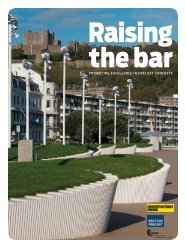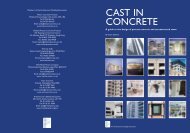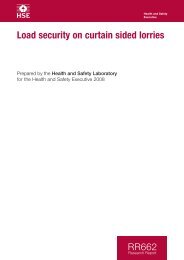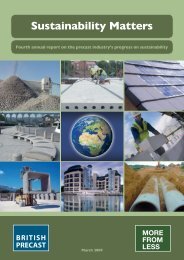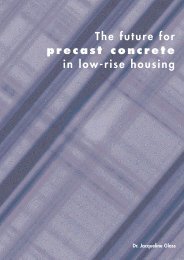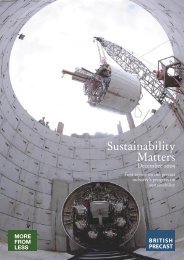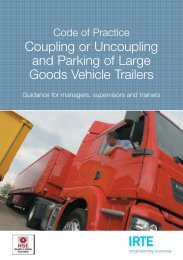The voice of concrete products - British Precast
The voice of concrete products - British Precast
The voice of concrete products - British Precast
You also want an ePaper? Increase the reach of your titles
YUMPU automatically turns print PDFs into web optimized ePapers that Google loves.
PRECAST CONCRETE SPECIAL EDITION<br />
Figure 3: Hanson’s<br />
Jetfloor Super system.<br />
radon to less than one-tenth <strong>of</strong> the original level.<br />
<strong>The</strong> member companies <strong>of</strong> the <strong>Precast</strong> Flooring<br />
Federation (PFF) have published, in conjunction with the<br />
Radon Council, a data sheet that covers the incorporation<br />
<strong>of</strong> membranes within the precast floor design. A radon barrier<br />
consists <strong>of</strong> a cavity tray through the wall linked to a<br />
membrane across the floor. Typically, the cavity tray is<br />
formed using a high-performance co-polymer thermoplastic<br />
damp-pro<strong>of</strong> course material or prefabricated cavity<br />
tray units. This is then sealed to a 1200-gauge polyethylene<br />
membrane laid across the beam-and-block floor.<br />
Penetration points due to services are sealed with ‘top<br />
hats’ and joints in the membrane are sealed with tape. <strong>The</strong><br />
micro-porous seepage through these membranes is almost<br />
negligible. Any precast <strong>concrete</strong> system can be used with<br />
the incorporation <strong>of</strong> a gas membrane.<br />
Of course, resistance to radon penetration is not the<br />
only benefit <strong>of</strong> a <strong>concrete</strong> beam-and-block floor. Seepage<br />
<strong>of</strong> methane on brownfield sites – something about which<br />
awareness is also spreading – is also prevented, and acoustic<br />
performance is improved. In addition, such floors are<br />
more cost-effective than timber and enable thinner floor<br />
zones as well as longer spans. <strong>The</strong>y are easy to install using<br />
semi-skilled labour and, for above-ground levels, provide<br />
a safe working platform for ongoing construction. Add to<br />
that their intrinsic one-hour minimum fire resistance and<br />
compatibility with other precast <strong>concrete</strong> components such<br />
as stairs and balconies and it is easy to see why the technique<br />
continues to gain ground.<br />
Although dealing with radon penetration later in the<br />
life <strong>of</strong> a building is fairly inexpensive, the remedy will<br />
probably require an annual maintenance and service contract.<br />
Compared with the cost <strong>of</strong> installing a membrane or<br />
plenum during construction, it is clear that the best thing<br />
to do is to install effective radon protection at the time <strong>of</strong><br />
construction. <strong>The</strong> PFF can supply names <strong>of</strong> those member<br />
companies that manufacture modified beam-and-block<br />
flooring. <strong>The</strong> system is available either as supply-only or<br />
preferably as supply-and-fix.<br />
Figure 4: CEMEX beamand-block<br />
flooring at<br />
ground-floor level on a<br />
residential site.<br />
Figure 5: Tarmac<br />
Topfloor’s Fastfloor<br />
Heatsave system.<br />
Concluding remarks<br />
Additional detailed information and advice on ways <strong>of</strong><br />
dealing with radon are available in BRE Report BR211 (1) .<br />
This report identifies the areas <strong>of</strong> England and Wales where<br />
measures should be taken to provide protection against<br />
radon and <strong>of</strong>fers guidance on the technical solutions that<br />
are required to satisfy Building Regulations requirements.<br />
<strong>The</strong> report can be purchased from:<br />
www.brebookshop.com.<br />
n<br />
Reference:<br />
1. BUILDING RESEARCH ESTABLISHMENT, BRE Report<br />
BR211. Radon: Protective measures for new dwellings.<br />
BRE Press, Bracknell, 2007.<br />
Reproduced f ro m CONCRETE December 2008/January 2009 © <strong>The</strong> Concrete So c i e t y, 2008 35









